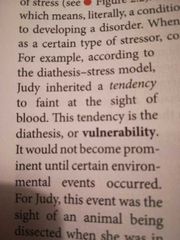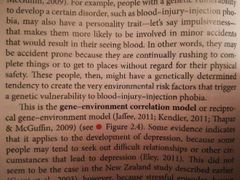![]()
![]()
![]()
Use LEFT and RIGHT arrow keys to navigate between flashcards;
Use UP and DOWN arrow keys to flip the card;
H to show hint;
A reads text to speech;
33 Cards in this Set
- Front
- Back
|
Multidimensional integrative approach |
Biological dimension: genetics and neuroscience. Psychological dimension: behavioural and cognitive processes. Emotional influences and developmental influences |
|
|
Genes |
M |
|
|
Diathesis-stress model |
Individuals inherit tendencies to express certain traits or behaviours which may then be activated under conditions of stress |
|
|
Vulnerability |

|
|
|
Gene-environment correlation model |

|
|
|
Neuroscience |
Knowing how the nervous system and especially how the brain works is central to any understanding of our behaviour, emotions and cognitive processes |
|
|
Neurons |
Nerve cells in the brain that control our thoughts and actions and transmit information throughout the nervous system |
|
|
Action potentials |
Within each neuron, information is transmitted through electrical impulses called action potentials, traveling along the axon of a neuron. |
|
|
Terminal buttons |
The end of an axon of a neuron |
|
|
Synaptic cleft |
The space between the terminal button of one neuron and the dendrite of another. Biochemicals released from axon, transfer impulse to dendrite receptors of next neuron |
|
|
Neurotransmitter |
Chemicals stored in vesicles in terminal buttons used to transfer messages between neurons |
|
|
Excitatory neurotransmitter |
Increase likelihood that the connecting neuron will fire. Excesses or insufficiencies in some neurotransmitters are associated with different groups of psychological disorders. |
|
|
Inhibitory neurotransmitter |
Decrease likelihood that the connecting neuron will fire. Excesses or insufficiencies in some neurotransmitters are associated with different groups of psychological disorders. |
|
|
Hormone |
Chemical messenger produced by each endocrine gland eg. Epinephrine (aka adrenaline) and thyroxine |
|
|
Brain circuits |
Paths for neurotransmitters |
|
|
Agonist |
Substances that increase activity of a neurotransmitter by mimicking its effects |
|
|
Antagonist |
Substance that decreases or blocks a neurotransmitter |
|
|
Inverse agonist |
Substance that produces opposite effect of a neurotransmitter |
|
|
Neuron reuptake |
After a neurotransmitter is released it is quickly broken down and brought back from the synaptic cleft into the same neuron that released it. |
|
|
Glutamate |
Excitatory transmitter that turns on many different neuron's leading to action |
|
|
GABA |
Amino acid inhibitory neurotransmitter, inhibits or regulates transmission of information and action potentials |
|
|
Serotonin |
Monoamine neurotransmitter, associated with inhibition and restraint, regulates behaviour, moods and thought processes. |
|
|
Norepinephrine |
Neurotransmitter, mobilise the brain and body for action |
|
|
Dopamine |
Neurotransmitter, associated with exploratory, outgoing, pleasure-seeking behaviours |
|
|
Learned helplessness |
When an animal learns their behaviour has no effect on their environment they give up any attempts to cope with difficult situations |
|
|
Social learning: modeling/observational learning |
Organisms don't have to experience certain events in their environment to learn effectively. They can learn just as much by observing what happens to someone else in a given situation |
|
|
Prepared learning |
We have become highly prepared for learning about certain types of objects or situations over the course of evolution because this knowledge contributes to the survival of the species |
|
|
Implicit memory |
When someone clearly acts on the basis of things that have happened in the past but can't remember the events |
|
|
Flight or fight response |
The alarm reaction that activates during potentially life-threatening emergencies |
|
|
Emotion |
Usually short lived temporary states lasting several minutes to hours, occurring in response to an external event. Linked to action tendencies, a tendency to behave in a certain way elicited by an external event and a feeling and accompanied by a characteristic physiological response. Associated with approach and avoidance tendencies. |
|
|
Mood |
Persistent period of affect or emotionality. |
|
|
Affect |
Valence dimension of an emotion (pleasant vs unpleasant). Eg. Positive affect is experienced during joy. |
|
|
Equifinality |
Used in developmental Psychopathology to indicate that we must consider a number of paths to a given outcome. One symptom may have a number of causes. |

